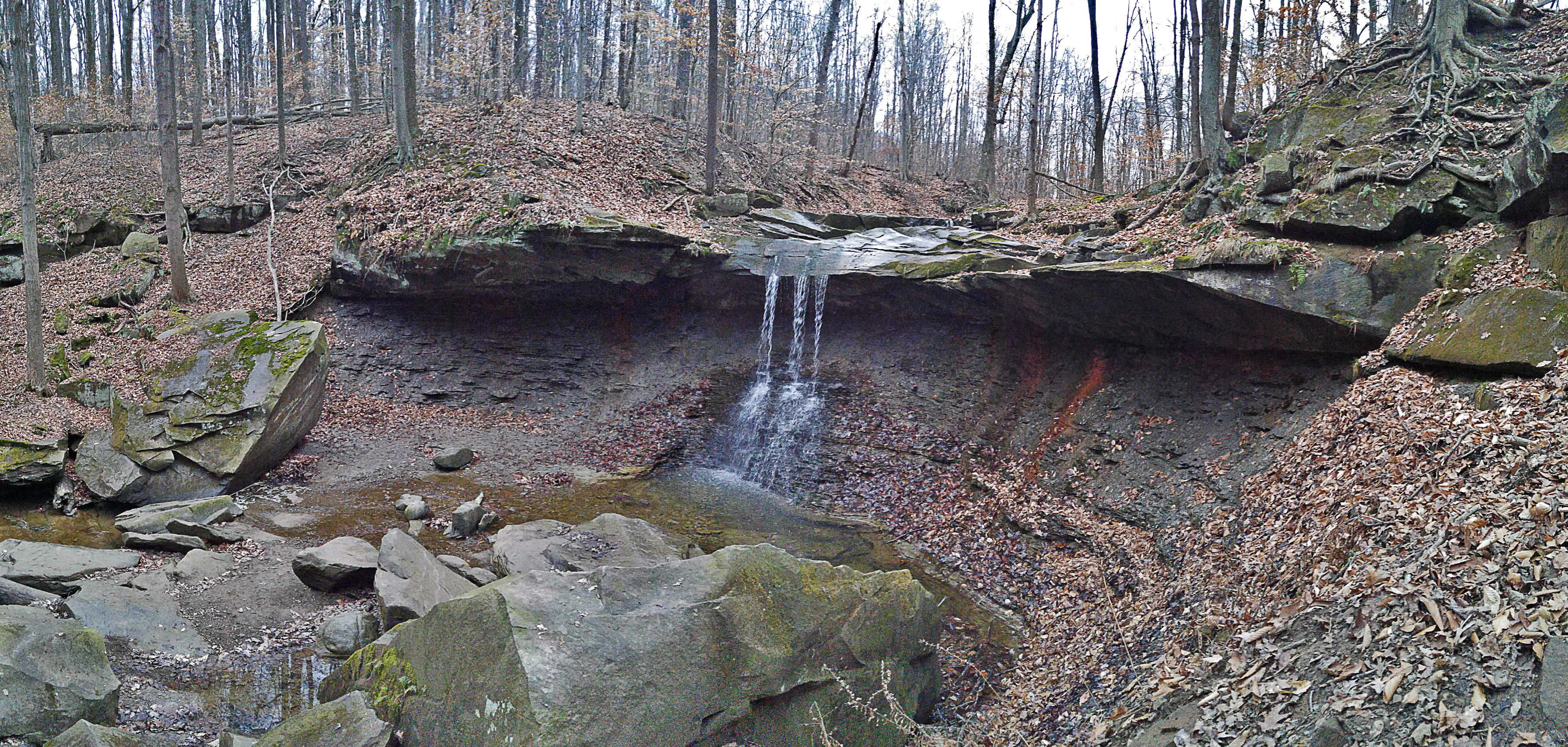 There exists in Cuyahoga Valley National Park a small waterfall called “Blue Hen Falls”. For thousands of years, this ripple of water has been flowing over a sandstone ledge in 3 ribbons, proceeding on its course towards the Cuyahoga River.
There exists in Cuyahoga Valley National Park a small waterfall called “Blue Hen Falls”. For thousands of years, this ripple of water has been flowing over a sandstone ledge in 3 ribbons, proceeding on its course towards the Cuyahoga River.
Spring Creek, it’s namesake being a natural seep about 1000 yards upstream, isn’t a spectacularly big watercourse. It’s no deeper than a few inches, and the falls are only 15 feet tall or so. There are no grand dams, shipping canals, or ports. It has been unaltered by man, and in my opinion, no improvement can be made upon it. It is beautiful and perfect just the way it is, and it feels as if it’s my place whenever I am there.
I shared this special place with Sarah last weekend. There were other people hovering around, visiting the falls, walking their dogs, or just taking in the views, but still it felt as if it was my place to share with Sarah. There are other, more imposing waterfalls in the park. There are a multitude of other streams, both large and small, taking different courses, flowing differently, and sometimes being altered by the progress of civilization through the years, but this small creek, no more than a trickle in comparison to many of the others, is still my favorite.
So goes our grief. There are people who have lost loved ones, and a flood of emotions overwhelms their banks for years, ceaselessly eroding a canyon into the bedrock of their hearts. Other persons may have allowed their riverbeds of grief to run dry, only flowing in the hardest of times. For the majority of us though, grief flows like a small creek after a passing storm.
When our loss occurs, our banks are overwhelmed. The trees along the riverbanks, those great cathedral pillars, use their roots to hold the soil fast against the flood. Those trees are the friends and families that support us through the hard times. Over time, some of those trees fall themselves, and the banks are left exposed and raw, ready to allow the next flood to carve the ravine a little deeper. Just as these giants fall, a new sapling will take its place not long after, riving its roots into the clay and sand to support the banks again.
After a bit of time, the great flood subsides. The flow of our grief slows a little, becoming more tranquil and steady. The time it takes for the waters to slow varies for each individual creek, just as each of us runs our own course. In the deepest of valleys, the water runs swift and sharp, cutting our landscapes into v-shaped gullies. These waters, while much more powerful and intense than the average flows, subside more quickly. The canyon becomes more able to weather the next storm. The walls or the ravine grow stronger, steeper, and more beautiful with each deluge.
Along the course of Spring creek, there is a spot where much softer shale bedrock lies underneath a hard, ancient sandstone. It is here, at Blue Hen Falls, where I found the most meaning. Over the years, flood after flood after flood has passed through and over this sandstone, and eventually, a flood came on so strongly that the waters seeped through a crack in that hardened cap. Swirling into this crevice, it began wearing away the softened underlying rock, chip by chip.
When the shale gave way, the falls were born. The rough, gray, angry stone that had supported the waters for eons existed only in broken boulders and scattered rubble downstream of this spot. The upper course, above the falls, is the long lived life before the flood. The sandstone is still present, showing us what this creek looked like in it’s youth. It is still a gentle stream above the head of the canyon, but when the rains come, that is the spot that becomes overwhelmed.
It’s fitting that the most beautiful portion of the creek is also where the largest catastrophe in its ten-thousand year history occurred. The falls are where the rest of the story of Spring Creek began. The valley grows deep and winding, and ever more wonderful beyond this point. There are new glades and ripples, shimmering in the sun around every small ridge and turn. When storms pass, it is this portion of the course that can now weather the floods quickly and efficiently. There are tributaries beyond this point; other watercourses that have their own stories and events that have shaped and carved their valleys over millennia. When these tributaries meet, they share a course, and work together to erode a deeper, more stunning, more capable canyon on their march towards their ultimate fate of being swallowed into the main stem of the river, joining thousands of other stories.
Water always flows downhill. Here, at the falls, is where I realized that although storms of grief can cause devastation to the flow of our lives and alter our courses, they can also create something much more amazing, powerful, and capable of weathering subsequent floods. The creek is best known for the falls, but it is the course and the story it created for itself beyond these falls that truly defines it.
